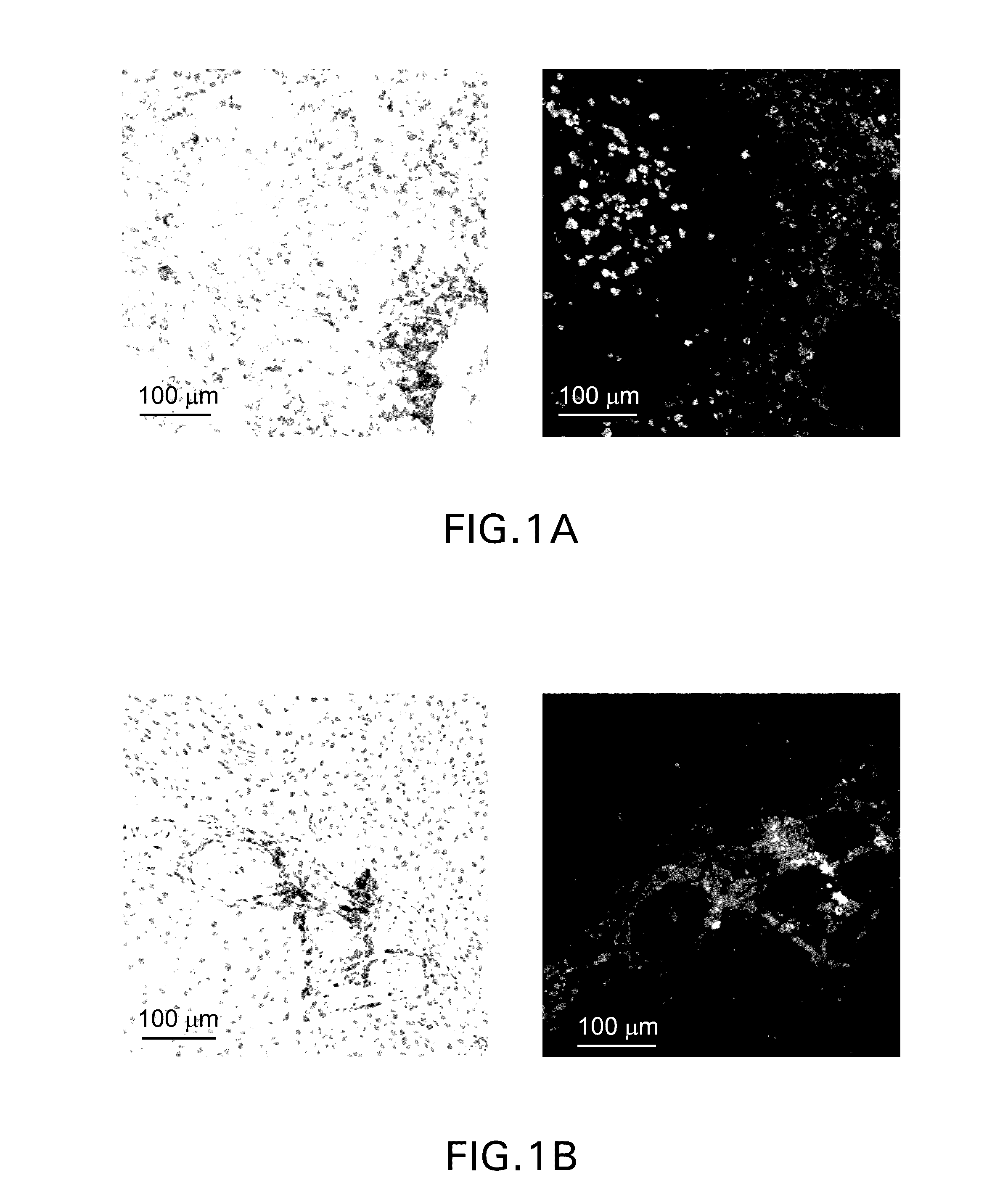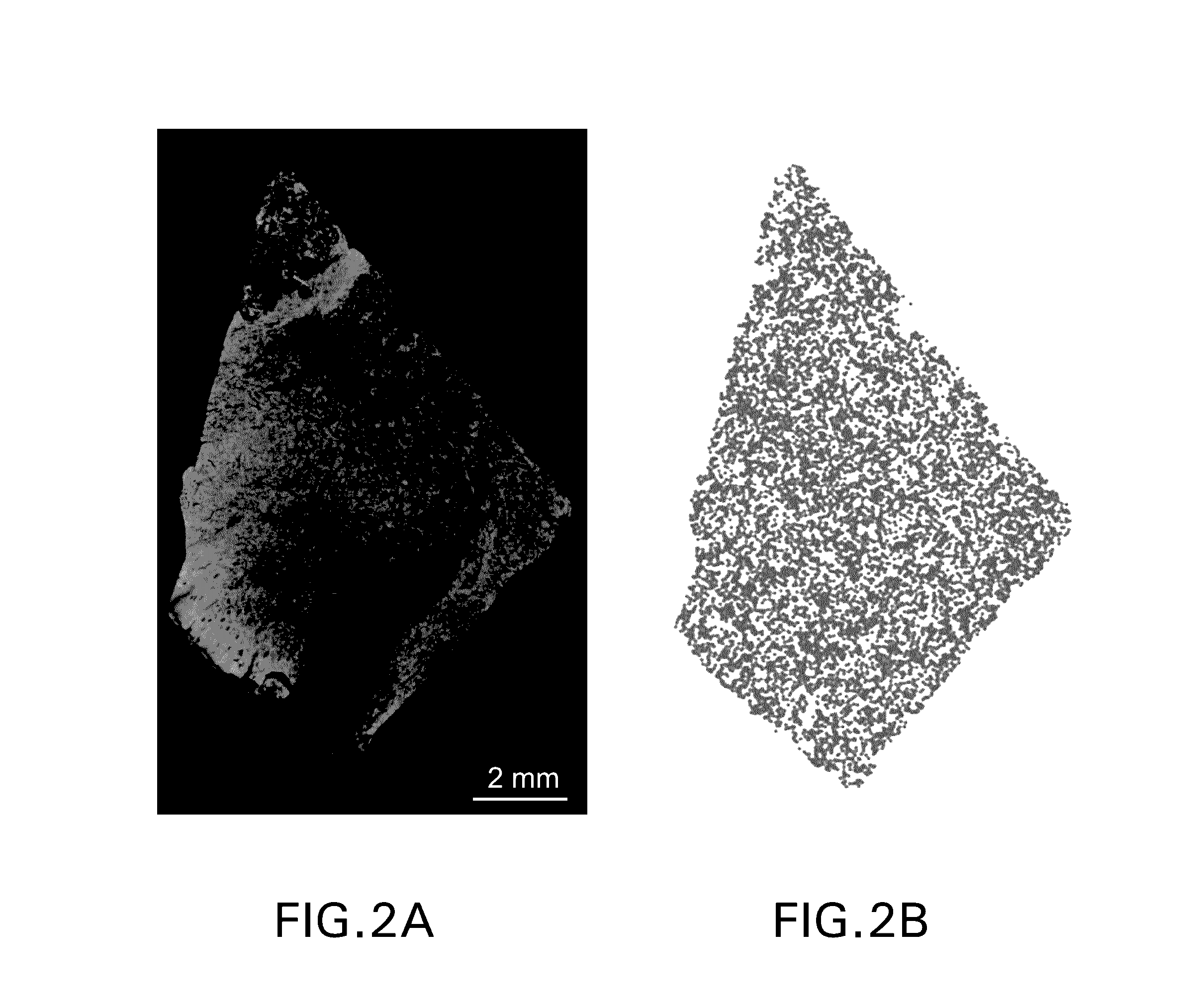Immunohistochemical proximity assay for pd-1 positive cells and pd-ligand positive cells in tumor tissue
a technology of immunohistochemical proximity and tumor tissue, which is applied in the field of cancer treatment, can solve the problems of significant patient failure to exhibit anti-tumor response, and achieve the effect of facilitating detection and quantification
- Summary
- Abstract
- Description
- Claims
- Application Information
AI Technical Summary
Benefits of technology
Problems solved by technology
Method used
Image
Examples
example 1
Multiplex IHC Assay for PD-1 and PD-L1 Expression in FFPE Tumor Tissue Sections
[0263]This example describes the process used to stain tumor samples for PD-1 and PD-L1 expression that were then imaged and assayed for proximity as discussed in the Examples below.
Reagents
[0264]
WorkingDescriptionCompanyCatalog #Conc.Mouse anti-human PD-L1 mAbIn houseN / A2 ug / mL(Clone 22C3)Envision Flex Mini Kit, High pHDakoK8023N / AEnvision FLEX+ MouseDakoK8022Ready to(LINKER)Use(RTU)Normal Donkey SerumJackson017-000-3 mg / mL1215% byvolumeGoat anti-human PD-1 polyclonalR&DAF10862 ug / mLAbDonkey anti-goat (biotinylated)Jackson705-065-6.5 ug / mL IgG147ABC EliteVectorPK7100RTUTSA Kit #4 withInvitrogenT-20914See TSAAlexa Fluor 568 tyramideprepTSA Kit #2 withInvitrogenT-20912See TSAAlexa Fluor 488 tyramideprepAntibody DiluentDakoS0809RTUMayer's HematoxylinPolyS216-1GLRTUScientificMicromountLeica3801731RTU
Preparation of Working Reagents from TSA Kit
[0265]Tyramide Stock Solution:
[0266]Dissolved component A into 15...
example 2
Multicolor Immunohistochemistry of Tumor (Melanoma) Samples Demonstrates Distinct Spatial Patterns of PD-1 and PD-L1 Distribution in Archival FFPE Melanoma Samples
[0276]Single parameter chromogenic immunohistochemical staining was performed using a mouse monoclonal anti-PD-L1 antibody (clone 22C3) and the brown DAB chromogen (FIG. 1, left column) Multiparametric fluorescence immunohistochemistry was performed using the protocol detailed in Example 1. In brief, formalin-fixed paraffin-embedded sections were stained using an anti-PD1 antibody (polyclonal goat anti-hPD-1, green) and an anti-PD-L1 antibody (clone 22C3, red). Representative patterns of PD-1 and PD-L1 are depicted in the images in the right-hand column. In contrast to the single parameter chromogenic stain, which is limited to demonstrating the range of PD-L1 expression per se, the dual fluorescence staining reveals distinct patterns of PD-L1 expression in relation to PD-1+ cells. PD-L1 can be identified as being either (...
example 3
Random Disc Sampling of Tissue Sections for Quantifying PD-1 Expressing Cells and PD-L1 Expressing Cells in Spatial Proximity
[0277]Multiparametric immunofluorescent immunohistochemistry was performed using the protocol detailed in Example 1. In brief, formalin-fixed paraffin-embedded sections were stained using an anti-PD1 antibody (green) and an anti-PD-L1 antibody (red). The slides were scanned using an Aperio ScanScope FL scanner (20× objective) and captured as afi fused sys files. The images were analyzed for staining artifacts such as the three fluorescent artifacts shown in FIG. 6. If found these artifacts were removed by the intensity distribution of individual channels that correspond to red pixels and green pixels and removed high intensity artifactual fluorescence around the edges of the stained tissue, low intensity artifactual fluorescence across the stained tissue, and used both shape and intensity information to remove the blood artifact. Once these artifacts were remo...
PUM
| Property | Measurement | Unit |
|---|---|---|
| diameter | aaaaa | aaaaa |
| pH | aaaaa | aaaaa |
| threshold proximity score | aaaaa | aaaaa |
Abstract
Description
Claims
Application Information
 Login to View More
Login to View More - R&D
- Intellectual Property
- Life Sciences
- Materials
- Tech Scout
- Unparalleled Data Quality
- Higher Quality Content
- 60% Fewer Hallucinations
Browse by: Latest US Patents, China's latest patents, Technical Efficacy Thesaurus, Application Domain, Technology Topic, Popular Technical Reports.
© 2025 PatSnap. All rights reserved.Legal|Privacy policy|Modern Slavery Act Transparency Statement|Sitemap|About US| Contact US: help@patsnap.com



